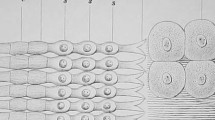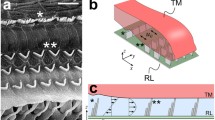Abstract
Motion or force generation of outer hair cells may contribute to active modulation of cochlear mechanics. In order to determine the force involved in length changes of outer hair cells, a new in vitro method was used. In the first series of experiments, apical and basolateral extracellular spaces of outer hair cells of the guinea-pig cochlea were separated. Changes of the voltage between the two extracellular spaces induced reversible, proportional changes of the cell length of 4.4 nm/ mV if the cell had a length of 80 μm. In the second series of experiments, cell elongations in response to negative pressure applied to the basal end of the cells were measured and corrected for frictional effects. From these data, the compliance of the longitudinal axis of the hair cells was calculated. It was 220±130 m/N (n =25) and 240±170 m/N /(n = 24) for cells of the third and fourth cochlear turns, respectively, if the water permeability of the cell membrane was neglected. If the water permeability was taken into account, the compliance was probably around 5 km/N. Thus, a mechanism that changes the cell length by 1 μm must generate a static force of at least around 200 pN in an outer hair cell of the organ of Corti. Electromotility of outer hair cells, induced by changes of the electrical potential difference across the outer hair cell, is a mechanism that generates this force.
Similar content being viewed by others
References
Ashmore JF (1987) A fast motile response in guinea-pig outer hair cells: the cellular basis of the cochlear amplifier. J Physiol (Lond) 388:323–347
Brownell WE, Bader CR, Bertrand D, de Ribeaupierre Y (1985) Evoked mechanical responses of isolated cochlear outer hair cells. Science 227:194–196
Dallos P (1983) Some electrical circuit properties of the organ of Corti. I. Analysis without reactive elements. Hear Res 12:89–119
Dallos P, Wang CY (1974) Bioelectric correlates of kanamycin intoxication. Audiology 13:277–289
Dallos P, Evans BN, Hallworth R (1991) Nature of the motor element in electrokinetic shape changes of cochlear outer hair cells. Nature 350:155–157
DeBoer E (1983) On active and passive cochlear models — toward a generalised analysis. J Acoust Soc Am 73:574–576
Gitter AH, Theis J (1987) A low-cost voltage stepper device for use in patch-clamp experiments. Pflügers Arch 408:194–195
Gitter AH, Zenner HP (1988) Auditory transduction steps in single inner and outer hair cells. In: Duifhuis H, Horst JW, Wit HP (eds) Basic issues of hearing. Academic Press, London, pp 32–41
Gitter AH, Rudert M, Zenner HP (1988) Cell-clamp technique to measure the compliance of mammalian cochlear outer hair cells in vitro. Pflügers Arch 412 [Suppl 1]:R 75
Gold T (1948) Hearing. II. The physical basis of the action of the cochlea. Proc R Soc Edinb [Biol Sci] 135:492–498
Hubbard AE, Mountain DC (1983) Alternating current delivered into the scala media alters sound pressure at the eardrum. Science 222:510–512
Kemp DT (1986) Otoacoustic emissions, travelling waves and cochlear mechanisms. Hear Res 22:95–104
LePage EL, Johnstone BM, Robertson D (1980) Basilar membrane mechanics in the guinea pig cochlea — comparison of normals with kanamycin-treated animals (abstract). J Acoust Soc Am 67 [Suppl] 1:S 46
Mountain DC (1980) Changes in the endolymphatic potential and crossed olivocochlear bundle stimulation alter cochlear mechanics. Science 210:71–72
Mountain DC (1986) Electromechanical properties of hair cells. In: Altschuler RA, Hoffman DW, Bobbin RP (eds) Neurobiology of hearing: the cochlea. Raven Press, New York, pp 77–90
Oberleithner H, Lang F, Messner G, Wang W (1984) Mechanism of hydrogen ion transport in the diluting segment of frog kidney. Pflügers Arch 402:272–280
Santos-Sacchi J, Dilger JP (1988) Whole cell currents and mechanical responses of isolated outer hair cells. Hear Res 35:143–150
Siegel JH, Kim DO (1982) Efferent control of cochlear mechanics? Olivocochlear bundle stimulation effects cochlear biomechanical nonlinearity. Hear Res 6:171–182
Weiss TF (1982) Bidirectional transduction in vertebrate hair cells: a mechanism for coupling mechanical and electrical processes. Hear Res 7:353–360
Zenner HP, Gitter AH, Zimmermann U, Schmitt U, Frömter E (1985) Die isolierte, lebende Haarzelle — ein neues Modell zur Untersuchung der Hörfunktion. Laryngol Rhinol Otol 64:642–648
Zenner HP, Gitter AH, Rudert M, Ernst A (1992) Stiffness, compliance, elasticity and force generation of outer hair cells. Acta Otolaryngol (Stockh) 112:248–253
Author information
Authors and Affiliations
Rights and permissions
About this article
Cite this article
Gitter, A.H., Rudert, M. & Zenner, H.P. Forces involved in length changes of cochlear outer hair cells. Pflügers Arch. 424, 9–14 (1993). https://doi.org/10.1007/BF00375096
Received:
Revised:
Accepted:
Issue Date:
DOI: https://doi.org/10.1007/BF00375096




